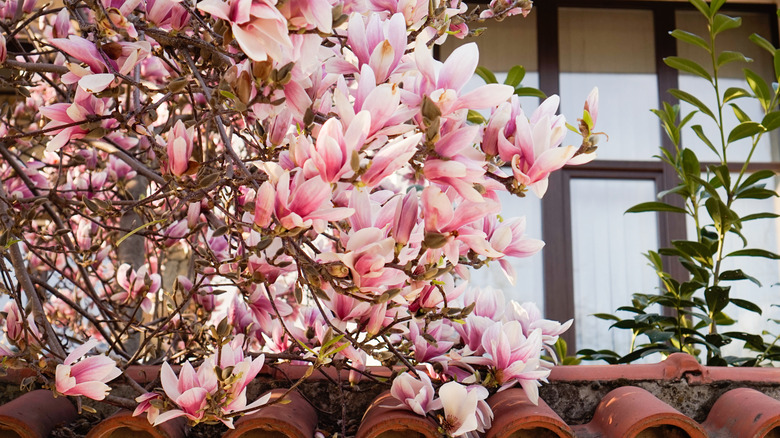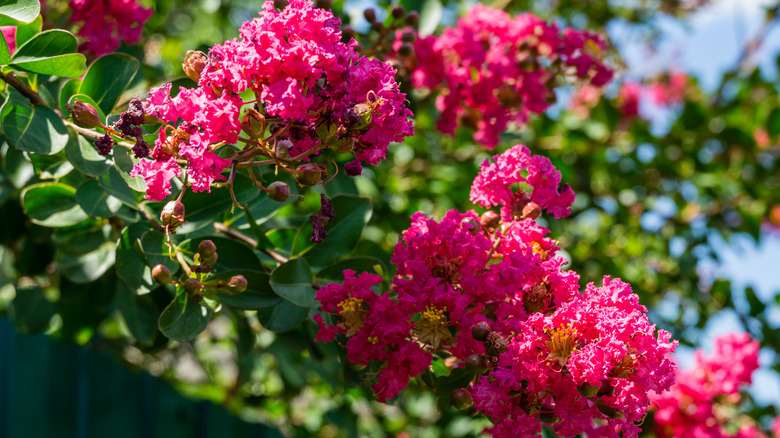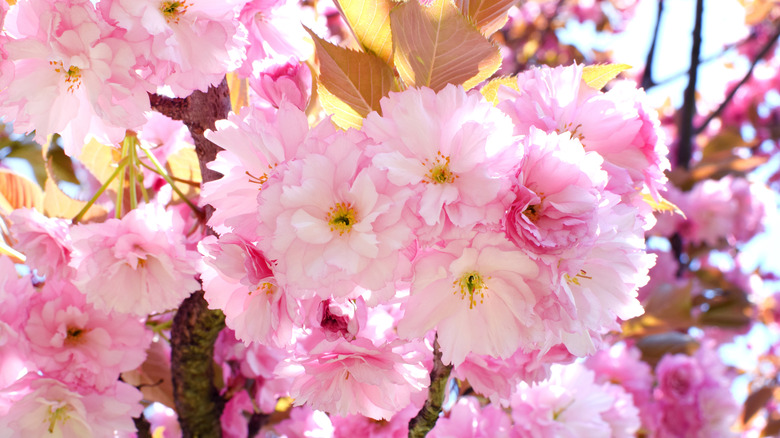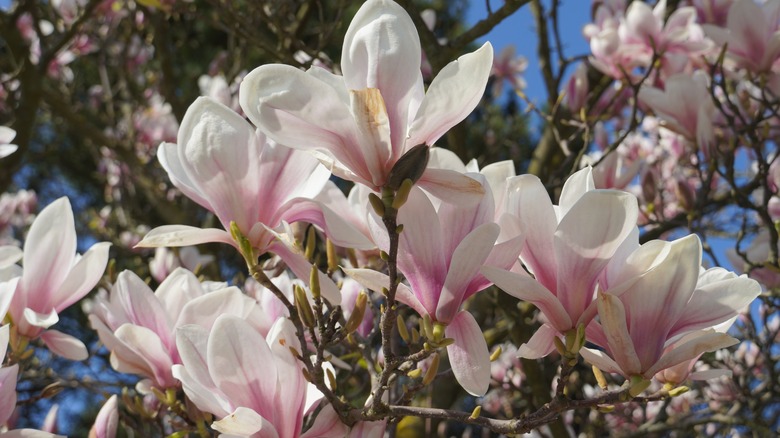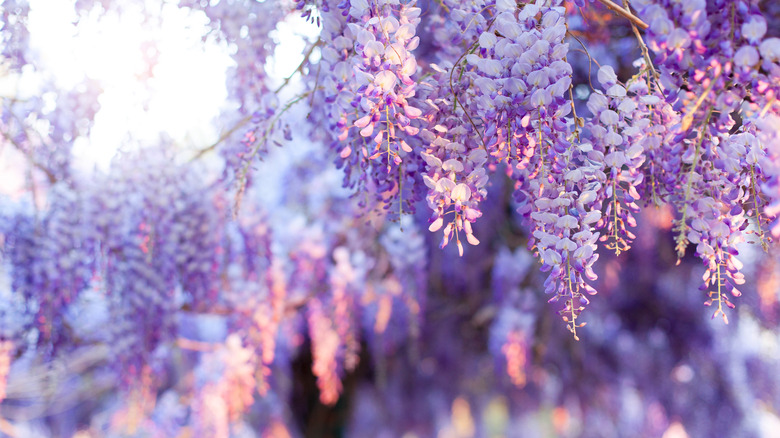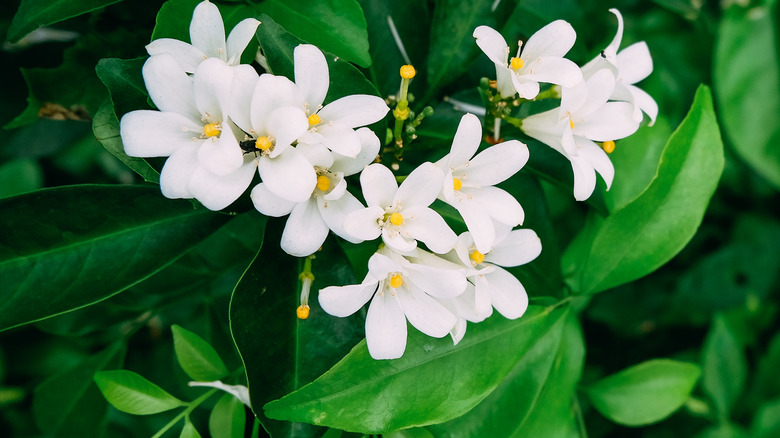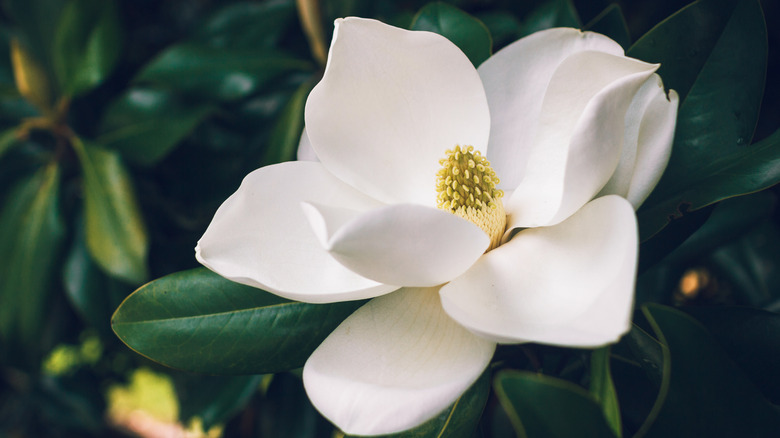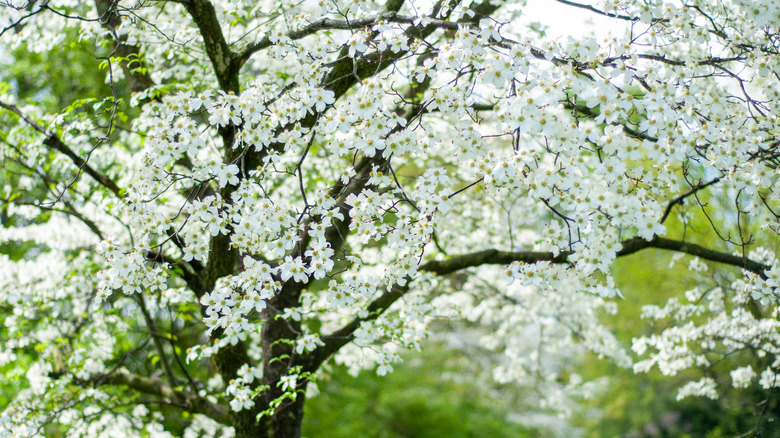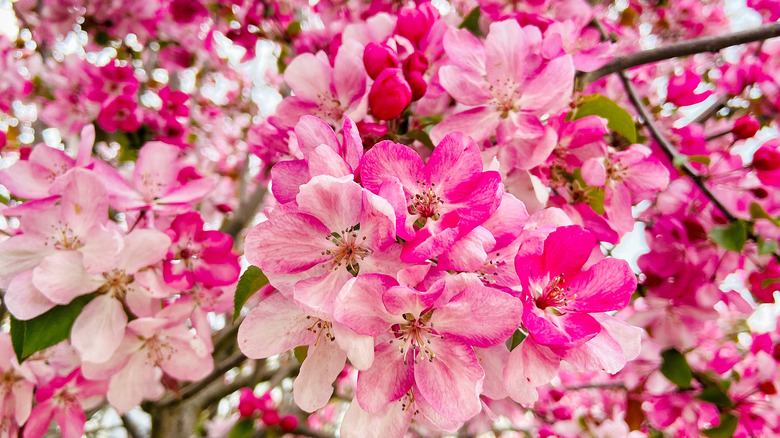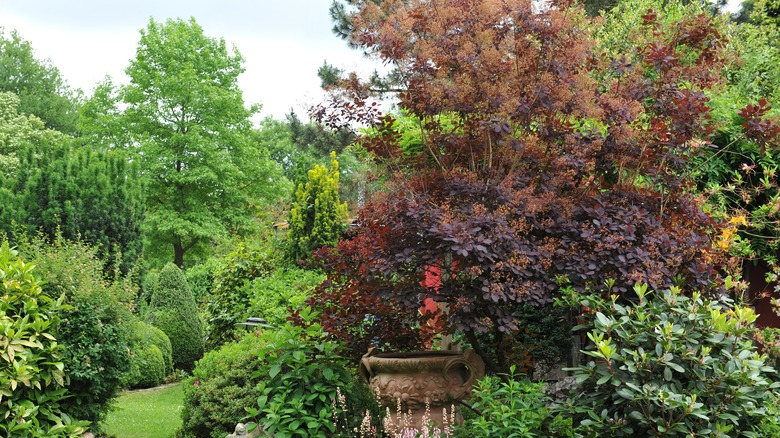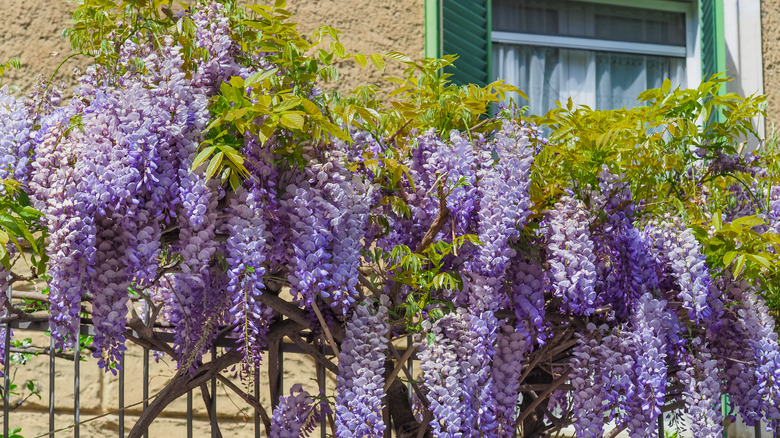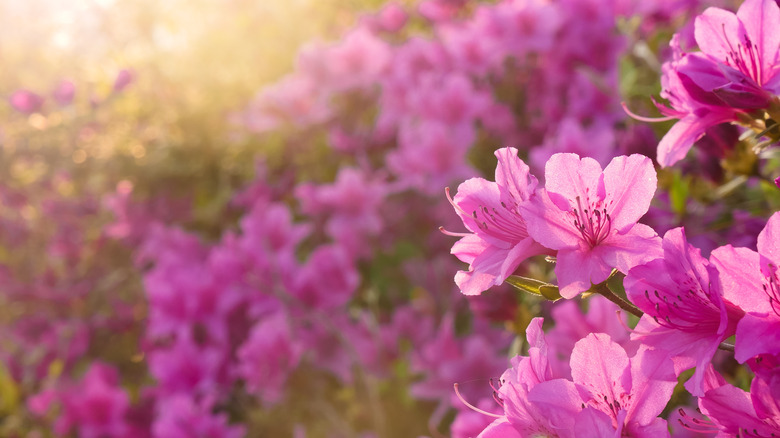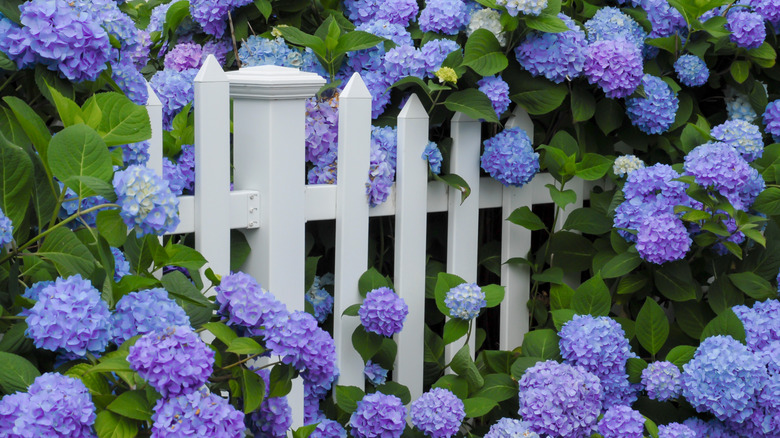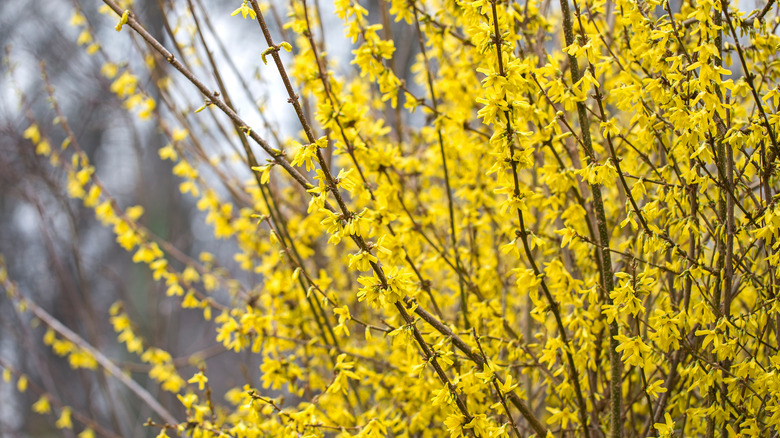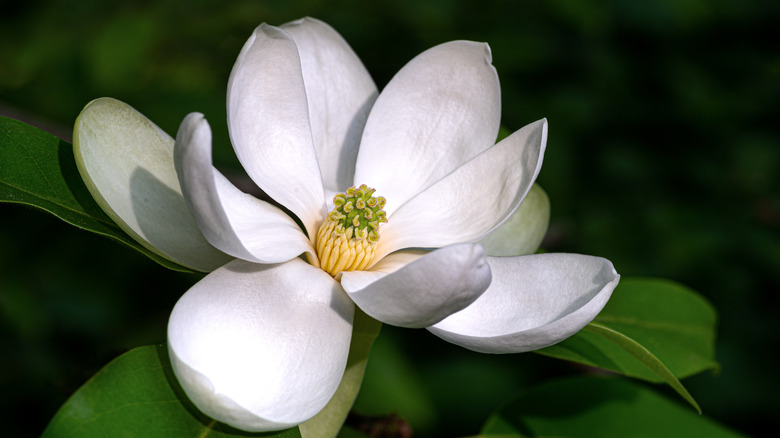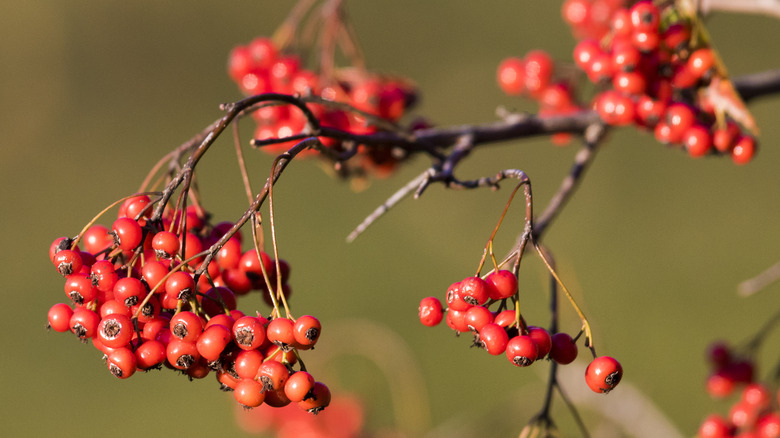15 Flowering Trees That Will Bring Romance To Your Yard
Want to plant a little romance within your home landscape? With endless varieties of flowering trees, there are several that encapsulate an aura of love and passion through their color, shape, or fragrance. Commonly known as angiospermae (or angiosperms), flowering trees produce seeds that bear various petals or fruits. Each season we are captivated by their exquisite blooms, which makes them so valued among gardens, parks, and roadways. Often used in weddings or for romantic gestures, flowers alone represent numerous things to us through their aesthetic nature, like the gentle and feminine white magnolia, often used in bridal bouquets, or the charming inspirational qualities of the Japanese cherry blossom, per Cornell Botanical Gardens. Layered with an amorous appeal, flowering trees and shrubs can also bring a romantic mood to your garden or grounds.
While picking out the perfect spot to plant your affectionate tree, determine the best space by the size of the tree and its potential growth. Additionally, be aware of any obstacles that might hinder its development that may need to be removed. According to Fast Growing Trees, you might plant your tree during the spring after the last frost or early fall, at least six weeks before the first chill. With so many fabulous flowering trees to choose from, here are 15 different types to inspire your landscaping project.
1. Crape myrtle
With its abundant variety of luscious colors like pink, white, red, or purple, crape myrtle (lagerstromeia indica) is a popular choice for an enduring romantic scene. Originating in Asia, according to IPM Florida, the ancient sprig-like tree features delicate petals resembling crepe paper and often symbolizes good fortune and love. Crape myrtle loves full sun, as seen above, as it attracts both bees and birds for pollination purposes.
Bloom season: Summer to fall
USDA Growing Zone: 6 to 9
Growing Conditions: Full sun
Soil Type: Rich, well-drained soil, clay, loamy, sandy
Size: Up to 25 feet tall and 15 feet wide
2. Kanzan cherry
Among the hundreds of cherry blossom cultivars, kanzan (prunus serrulata 'kanzan) is charmingly rustic and pink. Developed in China and Japan, it features double blooms with at least 20 to 50 petals on each flower. Like pretty pink wedding confection, the blooms spread about 2 ½ inches in diameter. According to Arbor Day Foundation, it does not fruit but shows lovely variances of orange and gold foliage in the fall.
Bloom season: April to early May
USDA Growing Zone: 5 to 9
Growing Conditions: Full sun
Soil Type: Most well-drained soils
Size: 30 to 40 feet in height x same spread
3. Saucer magnolia
Similar to the cherry blossom's coloring, the saucer magnolia (magnolia × soulangeana) displays tantalizing pinkish-purple blooms with a white interior. A hybrid relative of the southern magnolia, the spreading shrub was first cultivated in the early 1800's as its popularity continues throughout the U.S. and other parts of the world, per Arbor Day Foundation. Lovely dish like petals emerge abundantly each spring like this Chinese magnolia in bloom.
Bloom season: Early spring
USDA Growing Zone: 4 to 9
Growing Conditions: Full sun
Soil Type: Prefers most well-drained soils
Size: 20 to 30 feet
4. Wisteria
Enchanting at first sight, wisteria is part of the legume family fabaceae (leguminosae) and features heavy vine-like blue-violet blooms that hang over like a legendary fairytale. The bewitching tree has a sweet essence that butterflies and hummingbirds love and is low maintenance to grow in a variety of soils, according to Planting Tree. From spring to summer, wisteria reigns with its intricate pod-like flowers, as seen above.
Bloom season: April to June, sometimes August
USDA Growing Zone: 5 to 9
Growing Conditions: Full, partial
Soil Type: Prefers fertile, well-drained soils
Size: 6 to 10 feet, both tall and wide
5. White jasmine
Soft and delicate, jasmine (jasminum officinale) is a shrub often shaped into a tree and features white star-like shaped petals with an intoxicating scent. The elusive yet fragrant flowering plant is versatile, as it's used for various soothing, medicinal purposes, including anxiety, per Almanac. Native to various regions, jasmine has over 200 species and thrives in tropical and sub-tropical areas with its lush green foliage as pictured.
Bloom season: Spring to fall
USDA Growing Zone: 7B to 10
Growing Conditions: Full sun, partial shade
Soil Type: Fertile, well-drained soil
Size: 20 to 30 feet tall, 7 to 15 feet wide
6. Southern magnolia
Classic and fragrant, like an edible piece of fondant. Named after French botanist Pierre Mangol, southern magnolia (magnolia grandiflora) is a cold hardy evergreen known for its velvety white petals that contrast with their rich green leaves as seen above. Once the magnolia's pod opens, its seeds seductively fall out to hang by soft, silky threads, says Wildflower.
Bloom season: May to June
USDA Growing Zone: 6 to 10
Growing Conditions: Full Sun, Partial Sun/Shade
Soil Type: Well-drained soil, loamy or sandy soil
Size: 60 to 80 feet tall with a 40 foot spread
7. White dogwood
All dressed in white, the flowering dogwood (cornus florida) is strikingly beautiful as pictured. Well adapted to both northern and southern states, dogwood is Missouri and Virginia's state tree. While it's bark is used for medicinal purposes, it is also loved among birds and woodland creatures like squirrels, rabbits, and black bears. Dogwood loves weekly watering while its leaves turn reddish-purple with the change of fall, per Planting Tree.
Bloom season: Late March to mid-May
USDA Growing Zone: 5 to 9
Growing Conditions: Full morning sun, partial shade
Soil Type: Well-drained, slightly acidic soil
Size: Up to 35 feet tall
8. Prairifire crabapple
Make a pink statement. Bold in color, the prairifire crabapple (malus ioensis) is a thriving tree that boasts vibrant dark pink to red foliage, as seen here. With their changing colors, crabapple trees are members of the rose family (rosaceae) and are well-known to be disease-resistant, per Arbor Day Foundation. They are an exquisite addition to your home landscape, especially for wildlife with the edible fruit it produces.
Bloom season: April to May
USDA Growing Zone: 3 to 8
Growing Conditions: Full sun
Soil Type: Well-drained soils, slightly acidic soil
Size: Up to 20 feet high by 15 feet wide
9. Royal purple smoke tree
Deep and passionate, the royal purple smoke tree (continus coggyrgria 'Royal Purple') features dark foliage that compliments other lighter vegetation, trees, and shrubbery, mentions Monrovia. Native to the woodlands near the Mediterranean, the fascinating smoke bush showcases fire and smoke-like sprigs, which change color later in the season, as seen in this garden space.
Bloom season: Summer (June to August)
USDA Growing Zone: 5 to 8
Growing Conditions: Full sun
Soil Type: Most well-drained soils (Clay, Drought, Loamy, Sandy)
Size: Up to 15 feet tall x 12 feet wide
10. Lilac
With its alluring fragrance and color, lilac (syringa vulgaris) is synonymous with evoking emotions of love and innocence. Native to southeastern Europe, common lilac has hundreds of cultivars, including various rousing shades of purple, blue, pink, white, and yellow, says Britannica. This hardy spring shrub dresses well on its own as a hedge or privacy screen, as pictured cascading over a fence in blue lavender.
Bloom season: April and May
USDA Growing Zone: 3 to 7
Growing Conditions: Full Sun, Partial Sun/Shade
Soil Type: Well-drained soils (acidic, alkaline, moist, sandy)
Size: Rounded, up to 18 feet tall by 12 feet wide
11. Formosa azalea
Like a lush, tropical garden, bees and butterflies will flock to your azaleas (azalea indica 'formosa'). Native to southern India, the evergreen shrub showcases large 3-inch pink-magenta blooms that emerge in the spring and sometimes again in the fall, as seen here. Known as garden royalty, this bountiful bloomer is great for planting alone or along a border or hedge, says Almanac.
Bloom season: Spring (sometimes fall)
USDA Growing Zone: 8 to 10
Growing Conditions: Full Sun, Partial Sun/Shade
Soil Type: Well-drained soils (acidic, moist)
Size: 6 to 8 feet tall, 4 to 6 feet wide
12. Blue hydrangeas
Something classic and something blue, these hydrangeas (hydrangea macrophylla 'nikko') are a stand-out addition to a romantic-style garden. Cheerful yet calming, the dynamic blue rounded blooms love summertime, as they grow at a fast rate with floral clusters that reach about 4 to 8 inches in diameter, per Fast Growing Trees. You can expect them to mature after only two to three years.
Bloom season: Summer
USDA Growing Zone: 6 to 9
Growing Conditions: Full Sun, Partial Sun/Shade
Soil Type: Rich, well-drained soils (acidic, loamy, moist, sandy, silty loam)
Size: 3 to 6 feet tall and wide
13. Forsythia
An anticipated friend to spring, forsythia (forsythia x intermedia), or golden bell, brings cheer with its bright yellow blooms. Mainly from East Asia, the olive family (oleaceae) relative was officially named after Scottish horticulturist, William Forsyth, according to Owlcation. An early bloomer, the deciduous shrub entices landscapes through its lively spring energy, including a sense of hope amidst a gray sky seen above.
Bloom season: Early to mid-April
USDA Growing Zone: 5 to 8
Growing Conditions: Full Sun, Partial Sun/Shade
Soil Type: Well-drained soils (acidic, alkaline, loamy, moist, sandy, silty loam)
Size: 8 to 10 feet tall, 10 to 12 feet wide
14. Sweetbay magnolia
With pure romance, sweetbay magnolia (magnolia virginiana) is known for its lemony essence and plentiful 2-to-3-inch blooms. An eastern U.S. native, birds are often attracted to its red seeds during late summer, and it can be planted in low wetland areas, according to Morton Arboretum. Elegant and white, this magnolia offers its decadent petals to the light.
Bloom season: Late spring, early summer
USDA Growing Zone: 5 to 9
Growing Conditions: Full Sun, Partial Sun/Shade
Soil Type: Rich, well-drained soils, including acidic, loamy, moist, sandy, and silty loam
Size: 10 to 20 feet tall by 10 to 12 feet wide
15. Washington hawthorn
Prickly yet delightful, the Washington hawthorn (crataegus phaenopyrum) features late-blooming white flowers that offer nectar for bees along with protective, thorny branches, per NC State University. This hawthorn cultivar goes through various stages of color, from reddish-purple in the spring to green and white in the summer, then dark again in the fall. Darling little red berries appear in winter, like seen above, generally around the first snow.
Bloom season: Late May and early June
USDA Growing Zone: 4 to 8
Growing Conditions: Full Sun
Soil Type: Well-drained soils (acidic, alkaline, clay, loamy, moist, sandy)
Size: 25 to 30 feet tall
